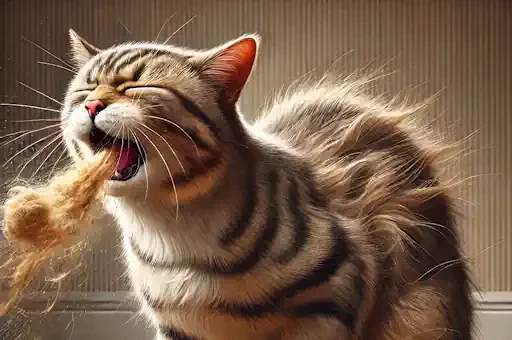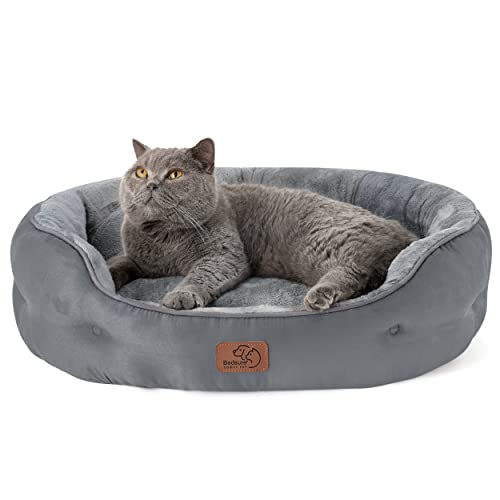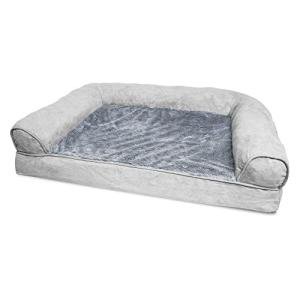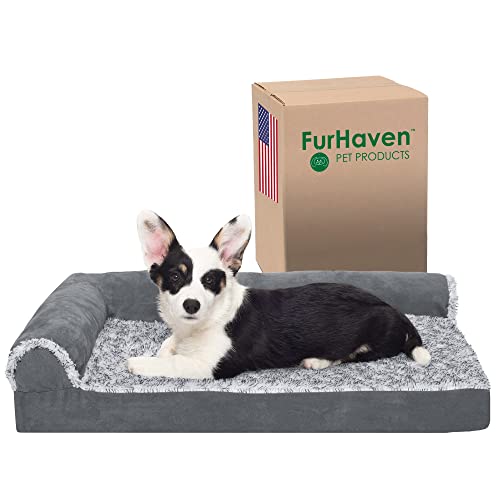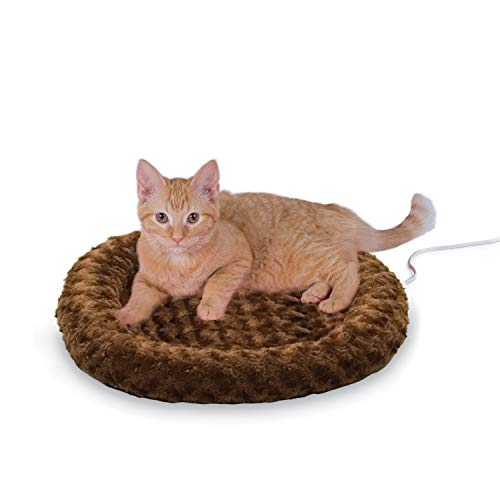That distinctive hacking sound echoing through the stillness of the night… followed by that unmistakable, unpleasant deposit suddenly appearing on your favorite rug. Ah yes, the quintessential joys of cat ownership – and the almost inevitable, sometimes dreaded, hairball. For many feline aficionados, the hairball is a familiar, if not entirely welcome, guest in their homes. It’s a sound, a sight, and an experience that, let’s be honest, no cat owner truly relishes. The retching, the gagging, the slightly concerning heaving motions… and then, the often-unceremonious presentation of the hairball itself. But while the hairball symphony might not be a chart-topping hit, it is, unfortunately, a common reality for many cats and their human companions. The good news, however, far outweighs the unpleasantness. Hairballs, while a normal feline phenomenon to a certain degree, are often preventable and, when they do occur, effectively manageable.
Let's be honest, no cat owner actually enjoys the hairball orchestra. That guttural rumble that erupts seemingly from nowhere, the series of increasingly concerning coughs and hacks, the desperate heaving motions… and the slightly… well, less-than-appealing aftermath that inevitably follows. It’s a sound that can instantly trigger a mix of concern and resignation in even the most seasoned cat parent. But before you resign yourself to a life perpetually armed with stain remover and a sympathetic ear for feline retching, take heart. While hairballs might be a common feline occurrence, they don't have to be a constant and disruptive presence in your or your cat's life. This isn’t about eliminating every single hairball – that might be an unrealistic goal for many furry felines. Instead, it's about understanding why they happen, taking proactive steps to prevent them from becoming a frequent issue, and knowing exactly how to manage them effectively when they do, inevitably, make an unwelcome appearance. This guide will equip you with a comprehensive understanding of feline hairballs, demystifying their formation, exploring the underlying causes, and, most importantly, arming you with a toolkit of practical strategies to prevent hairball formation and skillfully manage them when they occur. We'll delve into the preventative power of regular grooming, explore dietary adjustments that can make a real difference, emphasize the crucial role of hydration, and discuss the appropriate (and cautious) use of hairball remedies. We’ll also navigate the sometimes-confusing territory of managing a hairball episode, helping you to recognize the signs, provide comfort to your cat, and, crucially, understand when a hairball event warrants a visit to your veterinarian. Finally, we’ll bust some common hairball myths, separating feline fact from well-meaning, but often inaccurate, fiction. Our ultimate goal is to empower you, the devoted cat owner, with the knowledge and practical strategies to minimize hairball occurrences, effectively manage them when they do arise, and ultimately help your feline friend live a happier, healthier, and gloriously less hairball-prone life. Let’s embark on this journey to hairball harmony, transforming your home from a potential hairball battlefield into a haven of feline comfort and contentment.
Understanding the Feline Furry Foe: Why Do Cats Get Hairballs? - The Anatomy of a Hairball
To effectively combat the hairball menace, it's essential to first understand the enemy. Why do cats, these seemingly pristine and self-sufficient creatures, become afflicted with these unpleasant clumps of regurgitated fur? The answer lies in their meticulous grooming habits, a cornerstone of feline behavior and hygiene. Cats are, by nature, fastidious groomers, dedicating a significant portion of their waking hours to meticulously licking and cleaning their fur. This grooming behavior isn't just about vanity; it’s an essential part of their hygiene routine, helping them to remove loose fur, dirt, parasites, and distribute natural oils to maintain a healthy and lustrous coat. The secret weapon in their grooming arsenal is their tongue. A cat's tongue is covered in tiny, backward-facing barbs, called papillae, made of keratin – the same material as human fingernails. These papillae act like miniature hairbrushes, incredibly effective at grabbing and collecting loose fur as the cat grooms itself. While this barbed tongue is incredibly efficient at grooming, it also means that cats inevitably swallow a considerable amount of hair during their meticulous self-cleaning sessions. So, what happens to all that swallowed hair? In most cases, and in a perfectly functioning feline digestive system, the majority of swallowed hair simply passes through the digestive tract and is eliminated naturally in the cat’s stool. The digestive system is designed to process and move food and other indigestible materials through the body, and for many cats, small amounts of swallowed hair are handled without issue. However, sometimes, particularly with larger amounts of swallowed hair, or when the digestive system isn't functioning optimally, some hair can accumulate in the stomach. This is where the hairball formation process begins. The swallowed hair, unable to be properly digested or easily passed through the digestive tract in larger quantities, starts to clump together in the stomach. This clumping action is often aided by digestive fluids and any undigested food particles present in the stomach, creating a dense mass of fur, saliva, and stomach contents – the infamous hairball. Once a hairball forms and reaches a certain size, the cat's body instinctively recognizes it as a foreign and indigestible object that needs to be expelled. This triggers the natural expulsion process, resulting in the characteristic hacking, coughing, gagging, and retching motions we associate with a cat trying to get rid of a hairball. These often-unpleasant sounds and motions are the cat's body's natural attempt to push the hairball upwards through the esophagus and out of the mouth, effectively vomiting up the indigestible clump of fur.
It's important to understand the distinction between what is considered a “normal” occurrence of hairballs and when hairballs become excessive or a potential cause for concern. Occasional hairballs, perhaps once every few weeks or even once a month, can be considered somewhat within the realm of normal, especially for long-haired breeds or during heavy shedding seasons. However, frequent hairballs, occurring more than once or twice a month, or the expulsion of very large hairballs, should not be considered normal and may indicate an underlying issue that requires attention and preventative measures. Several factors can increase a cat's risk of developing hairballs and experiencing them more frequently. Long-haired cat breeds, such as Persians, Maine Coons, and Ragdolls, naturally have more fur to groom and are therefore more prone to swallowing larger quantities of hair, making them inherently more susceptible to hairballs. Heavy shedding seasons, typically during spring and fall, also significantly increase the amount of loose hair a cat grooms and swallows, increasing the likelihood of hairball formation for all cats, regardless of breed. Overgrooming, which can be triggered by stress, anxiety, skin allergies, or underlying skin conditions, can lead to a cat excessively grooming themselves, thus swallowing more hair and increasing hairball risk. Age can also play a role. Older cats sometimes groom themselves less effectively than younger cats due to arthritis or other age-related mobility issues, paradoxically leading to an increase in hairballs as they are less efficient at removing loose fur before swallowing it. Understanding these factors and the underlying mechanisms of hairball formation is the first crucial step in taking proactive measures to prevent and manage this common feline concern.
Prevention is Purr-fect: Strategies to Minimize Hairball Formation - Proactive Steps for a Hairball-Free Home (Almost!)
While hairballs may be a common feline experience, they certainly don’t have to be a constant and disruptive presence in your home. The excellent news for cat owners is that there are numerous effective and proactive strategies you can implement to significantly minimize hairball formation and reduce the frequency of those dreaded hacking episodes, paving the way for a more “hairball harmonious” existence for both you and your feline companion. Regular grooming is undeniably the first, and arguably most effective, line of defense against hairballs. Consistent brushing, even for short-haired cats, plays a pivotal role in removing loose fur before your cat has the chance to swallow it during self-grooming sessions. By proactively removing loose hair, you directly reduce the amount of hair that can accumulate in their digestive system and potentially form hairballs. Selecting the right brush for your cat’s coat type and your own grooming preferences can make the process more efficient and enjoyable for both of you. Slicker brushes, with their fine, bent wire bristles, are excellent all-purpose brushes, effective for removing loose fur and detangling mats in most coat types. Undercoat rakes, designed with longer, sturdier teeth, are particularly beneficial for long-haired breeds and cats with thick undercoats, effectively reaching deep into the coat to remove shed undercoat fur that is a major contributor to hairball formation. Grooming gloves, with rubber or silicone nubs on the palms, offer a gentler approach to daily grooming and are particularly well-suited for sensitive cats or for light, frequent brushing to remove surface loose hair.
The frequency of brushing should be tailored to your cat’s coat length and shedding level. Short-haired cats typically benefit from brushing 1-2 times per week, while medium-haired cats thrive with brushing 2-3 times per week. Long-haired breeds, and cats experiencing heavy shedding seasons, often require daily brushing, or even brushing every other day, to effectively manage loose fur and minimize hairball risk. Making grooming a positive and enjoyable experience for your cat is key to ensuring consistent cooperation and maximizing the effectiveness of your hairball prevention efforts. Introduce grooming gradually, starting with short, gentle sessions and gradually increasing duration as your cat becomes more comfortable. Use a gentle and reassuring approach, speaking in a calm voice and offering praise and treats throughout the grooming session. Associate grooming with positive things, such as playtime or favorite treats, to create a positive association in your cat's mind. Be patient, especially with cats who are initially hesitant about grooming. Start slowly, focus on areas they enjoy being touched, and gradually work your way up to brushing more sensitive areas.
Beyond grooming, dietary adjustments can play a significant role in hairball prevention. Feeding your cat a diet specifically formulated for hairball control or a diet naturally rich in fiber can aid in digestion and help move swallowed hair through the digestive system more efficiently. High-fiber diets, whether through specialized hairball formula cat foods or naturally fiber-rich ingredients, promote healthy digestion and bulk up stool, helping to carry swallowed hair through the digestive tract and prevent clumping in the stomach. Hairball formula cat foods are commercially available diets specifically designed to reduce hairball formation. These foods often contain increased levels of fiber, specific oils such as fish oil or flaxseed, and other ingredients formulated to lubricate the digestive tract and facilitate the passage of hair. Consider incorporating wet food into your cat’s diet. Wet food, with its higher moisture content compared to dry kibble, can contribute to better hydration, which is crucial for overall digestive health and can also aid in the smooth passage of hair through the digestive system. Hydration itself is a vital, and often overlooked, aspect of hairball prevention. Adequate water intake is essential for maintaining a healthy and well-functioning digestive system. Proper hydration helps keep the digestive tract lubricated and functioning smoothly, aiding in the efficient passage of food and, importantly, swallowed hair. Encourage your cat to drink more water through various strategies. Provide fresh, clean water daily, replacing water bowls with fresh water at least once a day, if not more frequently. Offer multiple water bowls in different locations around your home, making water readily accessible in your cat's favorite spots. Consider using a pet water fountain. Many cats are drawn to the sound and movement of flowing water and may be more inclined to drink from a fountain compared to a still bowl. Add water to your cat’s wet food to further increase their daily fluid intake, effectively combining hydration with mealtimes.
While proactive grooming, dietary adjustments, and ensuring proper hydration form the core foundation of hairball prevention, over-the-counter hairball remedies can be considered as supplementary tools, particularly for cats who are highly prone to hairballs despite these preventative measures. Various types of hairball remedies are available, primarily designed to lubricate the digestive tract and help hairballs pass more easily. Hairball pastes, often flavored to be palatable to cats, are lubricant-based gels that are typically given orally. These pastes coat swallowed hair, making it slick and easier to move through the digestive system and be eliminated in stool. Hairball chews and treats are another palatable option, often containing a combination of fiber, lubricants, and other ingredients aimed at reducing hairball formation. It is crucial to understand that hairball remedies are generally intended for reactive or short-term use, or preventative use in highly prone cats, and should not be considered a long-term solution or a substitute for consistent grooming, proper diet, and hydration. And, most importantly, always consult with your veterinarian before starting your cat on any hairball remedy, especially for regular preventative use. Your veterinarian can assess your cat’s individual needs, recommend the most appropriate type of remedy if necessary, and rule out any underlying health conditions that might be contributing to hairball issues. Over-reliance on hairball remedies without addressing underlying preventative measures can be detrimental and may mask more serious health problems. Remedies are best viewed as supplemental aids to a comprehensive hairball prevention strategy, not as a magic bullet or a replacement for consistent, proactive care.
Managing the Hairball Event: When Hacking Happens - Responding to a Hairball Episode and Knowing When to Worry
Despite your best preventative efforts, hairballs can still, occasionally, happen. Knowing how to recognize the signs of a hairball episode and how to respond appropriately is crucial for providing comfort to your cat and determining when a situation requires veterinary attention. Recognizing the telltale signs of a hairball episode allows you to differentiate it from other potential respiratory or digestive issues and respond accordingly. The most common and readily identifiable sign is the distinctive hacking, coughing, and gagging sounds that precede the expulsion of a hairball. These sounds are often quite characteristic and different from a typical cough or sneeze, often described as a dry, raspy, and persistent hacking. Retching or heaving motions are another key indicator. These motions, involving abdominal contractions and heaving of the body, are the cat’s physical attempt to expel the hairball from their stomach. Sometimes, and ideally, these hacking and retching motions are successfully followed by vomiting, where the cat expels the hairball, often accompanied by some stomach contents or digestive fluids. It's important to be able to differentiate hairball-related coughing and hacking from other potential respiratory issues or causes of vomiting that might require veterinary intervention. A hairball cough is typically followed by the expulsion of a hairball, or at least a clear attempt to expel a hairball. If the coughing or hacking persists and is not productive, meaning no hairball is expelled, or if it is accompanied by other concerning symptoms, it may indicate a different respiratory issue or other underlying health problem. Other symptoms that warrant concern and potential veterinary attention include lethargy, weakness, or noticeable loss of energy, significant loss of appetite or refusal to eat, persistent coughing that is not related to hairball expulsion, constipation or diarrhea, signs of respiratory distress such as difficulty breathing or wheezing, repeated and unproductive vomiting where the cat is trying to vomit but nothing comes up, the presence of blood in vomit or stool, a swollen or painful abdomen, or any other unusual or concerning symptoms that deviate from your cat’s normal behavior. If you are ever unsure or worried about your cat’s condition, especially during or after a suspected hairball episode, it is always best to err on the side of caution and consult with your veterinarian.
During a typical hairball episode, there are several things you, as a caring cat owner, can do to help your cat and manage the situation at home. First and foremost, stay calm and observe your cat. Panicking will not help either of you. Observe their behavior, note the sounds they are making, and assess if they are successfully expelling the hairball or if they are experiencing distress. Allow your cat to expel the hairball naturally. Interfering with the process is generally not advisable unless specifically instructed by your veterinarian in very rare circumstances (and even then, only under direct veterinary guidance). Your cat’s body is naturally attempting to resolve the issue, and interference can sometimes be counterproductive or even harmful. Provide a comfortable and quiet space for your cat. Offer them a calm and undisturbed area where they can feel safe and secure while they are going through the hairball episode. Have paper towels or cleaning supplies readily available. Be prepared for cleanup! Hairball expulsion can be messy, so having cleaning supplies on hand will make the aftermath easier to manage. Offer fresh water to your cat after the hairball episode is over. Vomiting can be dehydrating, so ensuring they have access to fresh water to rehydrate is important. However, as mentioned previously, certain red flags should trigger immediate concern and prompt a veterinary visit. Frequent hairballs, more than 1-2 per month, are considered excessive and warrant veterinary investigation. Persistent hacking or coughing without producing a hairball is a serious concern and requires immediate veterinary attention, as it could indicate a respiratory problem, foreign body obstruction, or other medical issue. Any of the concerning symptoms listed earlier (lethargy, loss of appetite, respiratory distress, bloody vomit, etc.) should prompt immediate veterinary consultation.
When you bring your cat to the veterinarian for hairball issues, they will conduct a thorough examination to diagnose the problem and rule out any underlying medical conditions. The vet will start with a physical exam, assessing your cat’s overall health, listening to their heart and lungs, and palpating their abdomen. They will ask you detailed questions about the frequency and characteristics of the hairballs, any accompanying symptoms you have observed, and your cat’s diet and grooming habits. Depending on the veterinarian's findings and concerns, they may recommend further diagnostic tests to rule out underlying conditions that could be mimicking or exacerbating hairball issues. Bloodwork may be recommended to assess overall organ function and rule out systemic illnesses. X-rays or other imaging techniques may be used to visualize the digestive tract and rule out intestinal blockages, foreign body ingestion, or other structural abnormalities. Treatment will depend entirely on the underlying cause of the hairball issues. If frequent hairballs are primarily due to excessive shedding or grooming habits, the vet will likely reinforce preventative strategies like increased grooming frequency, dietary adjustments, and hydration. In some cases, they may recommend specific hairball remedies or medications to aid in hairball passage. If the veterinarian suspects an underlying medical condition contributing to the hairball issues, such as gastrointestinal problems or respiratory diseases, treatment will focus on addressing the root cause. In rare and severe cases of hairball impaction causing complete intestinal blockage, surgery may be necessary to remove the obstruction, but this is an uncommon and usually preventable scenario with proactive care.
Busting Hairball Myths: Separating Fact from Feline Fiction - Common Misconceptions Debunked
In the realm of cat care, and particularly concerning hairballs, misinformation and outdated advice can sometimes circulate, often well-intentioned but ultimately inaccurate or even potentially harmful. Let’s debunk some common hairball myths and set the record straight on feline fact versus fiction. The myth that hairballs are simply "normal" and unavoidable for all cats is a pervasive and often misleading one. While occasional hairballs can happen, particularly for long-haired breeds or during heavy shedding seasons, frequent hairballs, occurring more than once or twice a month, are not normal and should be addressed proactively. Prevention is key, and with consistent grooming, proper diet, and adequate hydration, many cats can experience a significant reduction in hairball frequency. Frequent hairballs should not be accepted as simply “part of cat ownership” but rather viewed as a sign that preventative measures need to be implemented or that a veterinary checkup is warranted to rule out underlying issues. The myth that short-haired cats don't get hairballs is another common misconception. While long-haired breeds are undoubtedly more prone due to the sheer volume of fur they possess, all cats, regardless of coat length, groom themselves and swallow hair. Short-haired cats may produce hairballs less frequently than their long-haired counterparts, and their hairballs may be smaller, but they are certainly not immune. Short-haired cats can and do get hairballs, and preventative measures are equally important for all feline coat types. The over-reliance on hairball remedies as a “cure-all” is another myth that needs debunking. Hairball remedies, such as pastes and chews, can be helpful tools for managing hairballs and aiding in their passage, but they are not a substitute for consistent preventative care. They are best viewed as supplementary aids, not as a magic bullet that eliminates the need for regular grooming, proper diet, and hydration. Relying solely on remedies without addressing the underlying causes of hairball formation is not a sustainable long-term solution. The minimization of hairballs as “just a cat thing” and not a real health issue is a myth that can be detrimental to feline well-being. While infrequent hairballs are often not serious and are simply a natural byproduct of grooming, frequent hairballs can be a symptom of underlying digestive issues, overgrooming due to stress or skin allergies, or other medical conditions. Furthermore, in rare cases, large or impacted hairballs can cause intestinal blockages, which are serious and potentially life-threatening medical emergencies requiring veterinary intervention. Therefore, hairballs, especially frequent or severe ones, should be viewed as a potential health concern that warrants proactive prevention and veterinary consultation if they become excessive or are accompanied by concerning symptoms. Finally, the outdated and potentially harmful myth that feeding cats cream or butter helps with hairballs should be firmly debunked. This old wives’ tale suggests that dairy products can “lubricate” the digestive tract and aid in hairball passage. However, dairy products are not a natural part of a cat’s diet and can often cause digestive upset, including diarrhea and vomiting, in lactose-intolerant felines, which are the majority of adult cats. Furthermore, cream and butter are high in fat and calories and are not a healthy or effective way to manage hairballs. Modern, veterinarian-recommended hairball remedies, such as pastes and specialized diets, are far safer, more effective, and healthier options for addressing feline hairball issues, always under the guidance of your veterinarian.
Conclusion: Living in Harmony with Your Hairball-Prone Feline - Happy Cat, Happy Home, Fewer Hairballs
While the hairball symphony, with its hacking crescendo and… well, less-than-melodious finale, may be an unavoidable feline quirk for some, it certainly doesn’t have to be a constant and disruptive refrain in your home. By understanding the mechanisms behind hairball formation and diligently implementing the preventative strategies outlined – regular and effective grooming, a diet formulated for hairball control or rich in natural fiber, ensuring good hydration, and the judicious use of hairball remedies when appropriate and veterinarian-approved – you can significantly reduce their frequency and overall impact on your feline friend and your household sanity. Remember, preventative care is purr-fect, and proactive steps are always more effective than simply reacting to hairball events. Reiterate those key preventative measures: consistent and thorough grooming, choosing an appropriate diet, ensuring your cat drinks plenty of water, and consulting your veterinarian before using any hairball remedies, particularly for preventative purposes. And remember, crucially, to recognize those red flags that signal a hairball situation is beyond the realm of “normal” and warrants a prompt veterinary visit. Persistent hacking without hairball production, frequent hairballs, lethargy, loss of appetite, or any other concerning symptoms are your cues to seek professional veterinary guidance. Hairballs are indeed a common feline challenge, but with knowledge, proactive care, and a touch of feline-whispering patience, they are entirely manageable. Embrace the preventative strategies, learn to recognize when management is needed, and most importantly, continue to cherish the many joys of cat ownership, hairball episodes and all – but hopefully, with significantly fewer hairballs enriching your rugs and your late-night listening experiences. Here's to fewer hacking sounds, more contented purrs, and a wonderfully hairball-harmonious home, where both you and your beloved cat can thrive in comfort and feline-human companionship.
